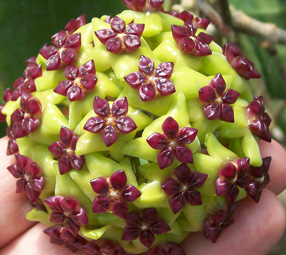Vireya Rhododendrons are not difficult to grow, especially in the more temperate areas of New Zealand where they may be freely grown outside in garden beds. For cooler parts of the country they may be kept in pots and moved to a more protected spot indoors over winter. They do not like frost or extended periods of very cold weather.
Growing Mediums – In their natural environment they are epiphytic, growing in the crooks and branches of trees, or if growing on the ground they cling to the cracks and crevices of slopes and banks. They do not like their roots to be deeply covered in thick soil, instead preferring a light, free-draining mixture. We plant our outdoor plants into ordinary bark mulch and our potted plants into a bark, peat and pumice mix. They seem to respond well to both of these.
Water Needs – Over the drier summer periods water thoroughly, ensuring that the water drains away. Let the plants dry out to the point that the soil around them is barely moist and then water again. Over winter they do not require much watering as the ground is generally moist anyway.
Feeding – Do not overfeed your plants. Give them a regular, low-dosage of fertiliser, and an occasional foliar feed.
Growing Position – Some Vireyas will take more sun than others and some become more tolerant of the sun as the plants mature. Morning sun is fine as long as the plants are protected from strong, full afternoon sun. We grow most of ours in filtered light.
Pruning and Shaping – Vireyas have a reputation for becoming leggy. Avoid this by pinching out the tips of younger plants to encourage bushiness. Keeping them low encourages new shoots to come up from the bottom of the stems. If your Vireya has already become leggy then prune it back hard after flowering. It, also will eventually shoot up from the bottom.
Planters and Baskets – Some Vireyas have a drooping habit. Take advantage of this and plant them in planters and baskets. Many of the smaller leaved varieties such as Silver Thimbles or Tom Thumb look great treated in this way.
Filed under: Gardening, How To Grow..., Northland, Sub-tropical | Tagged: Rhododendron, Vireya | Leave a comment »






















